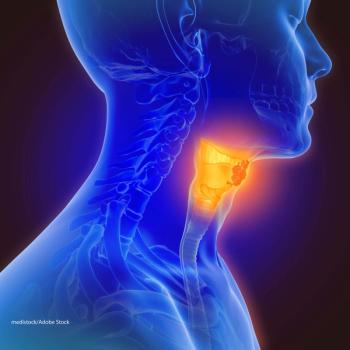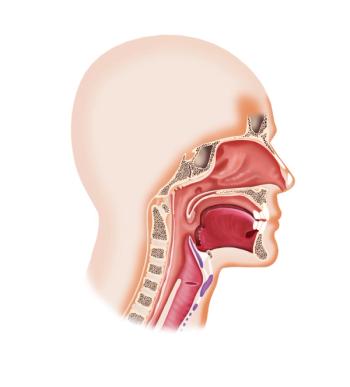
Oncology NEWS International
- Oncology NEWS International Vol 11 No 2
- Volume 11
- Issue 2
Concurrent Radiotherapy Plus Chemotherapy Ups Survival in Advanced Head and Neck Cancer
CHICAGO-Radio- and chemotherapy delivered concurrently produced greater overall and disease-free survival than radiotherapy alone in RTOG 9703, a phase II randomized trial of patients with advanced squamous cell carcinoma of the head and neck. The RTOG 9703 trial compared three treatment approaches using different chemotherapeutic agents, integration strategies, and timing sequences against the results of clinical studies involving radiotherapy alone.
CHICAGORadio- and chemotherapy delivered concurrently produced greater overall and disease-free survival than radiotherapy alone in RTOG 9703, a phase II randomized trial of patients with advanced squamous cell carcinoma of the head and neck. The RTOG 9703 trial compared three treatment approaches using different chemotherapeutic agents, integration strategies, and timing sequences against the results of clinical studies involving radiotherapy alone.
Concurrent combined radio- and chemotherapy achieved overall median 2-year survival rates of 60% to 70%, Adam Garden, MD, reported at the Second International Chicago Symposium on Malignancies of the Chest and Head & Neck.
"What is most striking is that 2-year survival, particularly in two arms of the study, is better than 1-year survival with radiotherapy alone," said Dr. Garden, associate professor of radiation oncology, M.D. Anderson Cancer Center. "Concurrent radio- and chemotherapy produced at least a 50% reduction in death rates, compared with historical controls from the 1970s, and disease-free survival ranging from 34% to 50% at 2 years."
The regimens also had acceptable toxicities. Dr. Garden said that three episodes of grade 5 toxicities secondary to treatment and sepsis occurred in one arm of the study. Grade 4 toxicities occurred at a rate of about 30% in all treatment arms, compared with 8% in previous studies of aggressive radiotherapy alone.
"The RTOG trial has shown in a randomized phase II effort that intensive therapy can be given and given safely," concurred Merrill S. Kies, MD, professor of thoracic/head and neck medical oncology, M.D. Anderson Cancer Center.
Study Protocol
RTOG 9703 analyzed 227 patients out of a total enrollment of 241 patients with stage III or IV M0 squamous cell carcinoma of the oral cavity, oropharynx, or hypopharynx. Patients were randomized to one of three arms. In the first arm, patients received 70 Gy of radiation therapy for 7 weeks and cisplatin (Platinol) 10 mg/mg² and fluorouracil (5-FU) 400 mg/m² daily for the last 10 days of the treatment course. Patients in the second arm received 70 Gy of radiation therapy on an alternate-week basis for a total of 13 weeks as well as hydroxyurea (Hydrea) 1 g twice daily and 5-FU 800 mg/m² every day. In the third arm, patients received 70 Gy of radiation therapy for 7 weeks with cisplatin 20 mg/m² and paclitaxel (Taxol) 30 mg/m² every week.
Median 1- and 2-year survival rates and toxicities were compared with survival and safety data compiled in the RTOG database from trials involving radiotherapy alone, with or without a sensitizer, and RTOG 8117, in which patients received 70 Gy of radiotherapy plus 100 mg/m² cisplatin on weeks 1, 4, and 7.
Study Results
Median 1-year survival rates in RTOG 9703 were 71% for patients in the first arm of the study, 88% for patients in the second arm, and 80% for patients in the third arm. Median 2-year survival rates were 59%, 70%, and 70% for the three arms, respectively. In contrast, median survival rates for patients in the RTOG head and neck cancer database who received radiotherapy alone were 59% at 1 year and 35% at 2 years. Median 1- and 2-year survival rates were 58% and 46%, respectively, in RTOG 8117.
Locoregional failure was the most dominant form of treatment failure, occurring in 30% to 43% of patients; distant metastases were found in 20%.
Dr. Garden stated that phase III trials are being mounted to investigate several issues related to findings from RTOG 9703, including use of chemotherapy intensification (two chemotherapy agents vs one agent) or radiotherapy intensification (standard fractionation vs altered fractionation) when delivering concurrent chemoradiotherapy, as well as newer agents that may not only improve curability but also prove to be less toxic.
Articles in this issue
almost 24 years ago
R115777 Has Significant Activity in CML and Myelofibrosisalmost 24 years ago
National Cancer Prevention Campaign Discussedalmost 24 years ago
CHOP Plus Rituxan Proves Cost-Effective in B-Cell Lymphomaalmost 24 years ago
Lung Cancer Screening Protocol Moves Forwardalmost 24 years ago
Cancer Prevention Research Hampered by Lack of Biomarkersalmost 24 years ago
Rituximab Improves Efficacy of Chemotherapy for Follicular Lymphomasalmost 24 years ago
Long Survival Confirmed in CML Patients Who Respond to InterferonNewsletter
Stay up to date on recent advances in the multidisciplinary approach to cancer.





